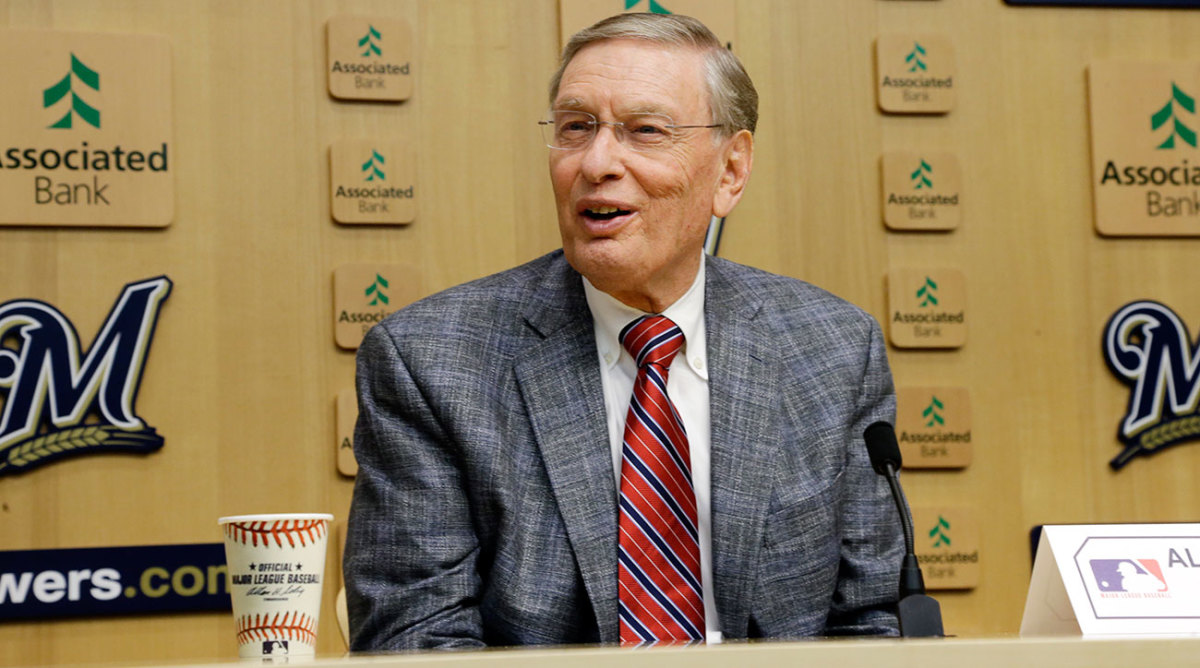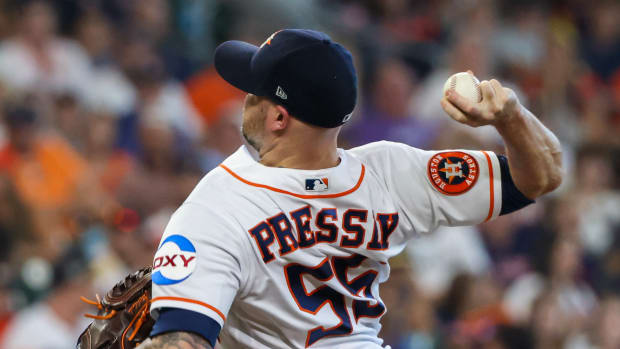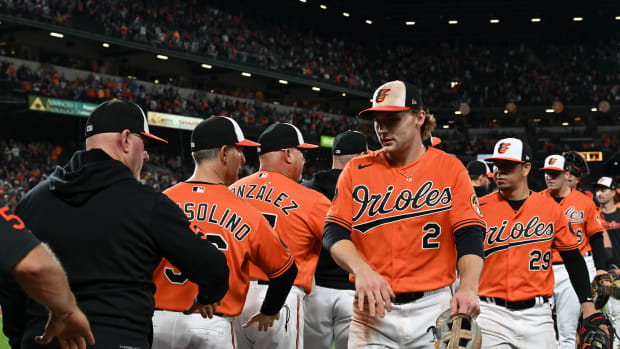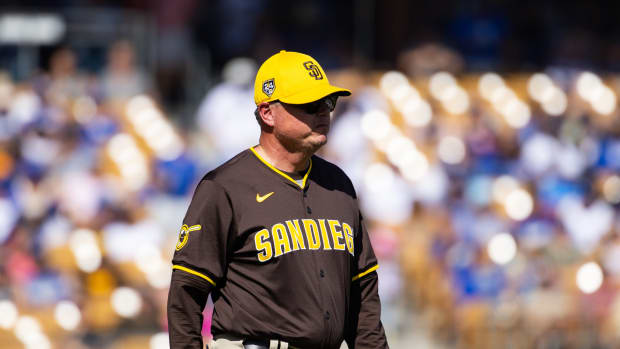Breaking down the Today's Game Hall of Fame ballot, Part 4: Bud Selig
The following article is part of my ongoing look at the candidates on the 2017 Today’s Game Era Hall of Fame ballot, which will be voted upon by a 16-member committee of writers, executives and Hall of Fame players on Dec. 4 at the Winter Meetings in National Harbor, Md., with the results to be announced that night at 6 p.m. ET. For a detailed introduction to the Today’s Game Era ballot, please see here.
Including Rob Manfred, who took over the post in January 2015, there have only been 10 commissioners of Major League Baseball, starting with Judge Kenesaw Mountain Landis, whom the owners appointed to the position in 1920. In the wake of the Black Sox scandal—the throwing of the 1919 World Series by the White Sox—the owners wanted an outsider to act “in the best interests of baseball” to clean up the game, granting him the final authority. Landis held the job until his death 24 years later, and among the mixed bag of his successors, nobody held onto power longer than Bud Selig, whose lack of a charismatic public persona took a back seat to his backroom savvy. But although his election to the Hall of Fame via the Today's Game Era ballot is a near-certainty, his career is worth review.
First known for helping to bring major league baseball back to Milwaukee, Selig left an even bigger imprint on the game during his 22-year run (1993–2015) as MLB's ninth—and arguably best—commissioner. His legacy is a complex one, for he presided over unprecedented growth in attendance and revenue, two waves of expansion, numerous innovations and technological modernization. He was at the helm for two of baseball's darkest moments since the Black Sox—the cancelation of the 1994 World Series and the proliferation of performance-enhancing drugs within the game—yet he stuck around long enough to clean up those messes and left office with MLB amid the longest run of labor peace of any major North American sport and with the most comprehensive drug program.
What MLB’s new CBA means for the league and its players
The son of a Romanian immigrant father and a Russian immigrant mother, Allan Huber "Bud" Selig was born in Milwaukee. Though he would follow his father into the automobile industry after graduating from the University of Wisconsin-Madison, it was his mother who kindled his love of the game with regular visits to see the minor league Brewers, not to mention a six-week trip to New York in 1949, where they saw Joe DiMaggio, Yogi Berra, Jackie Robinson and other greats in the city's three ballparks. Elated when the Braves moved from Boston to Milwaukee for the 1953 season, Selig became not only a fan but also the team's largest public shareholder after they went public ten years later.
Alas, as a non-voting minority owner, Selig couldn't stop the franchise's transfer to Atlanta for the 1966 season, though he founded an organization called Teams Inc. that unsuccessfully sued to keep them in town. He divested his stock when the Braves moved, renamed his group "Milwaukee Brewers Baseball Club Inc." and battled tenaciously to bring major league baseball back to town. He fell short when applying for one of the two National League expansion franchises to be awarded for the 1969 season, then had an agreement to buy the White Sox—whom he had brought to Milwaukee County Stadium for 20 games in 1968–69 and intended to relocate there —vetoed by the league.
Finally, when the Seattle Pilots—one of the AL's two expansion teams in 1969—filed for bankruptcy just before Opening Day in '70, Selig and his group bought the franchise for $10.8 million. So last-minute was the transfer that the team’s equipment truck sat in Provo, Utah en route from spring training in Arizona, awaiting instructions on whether to head for Seattle or Milwaukee, and the uniforms were merely the Pilots’ jerseys with the insignia and old team name stripped off in favor of the new one and the blue-and-yellow color scheme preserved rather than changing to the navy-and-red of the minor league Brewers.
The Brewers did not immediately flourish under Selig, who served as club president and later added CEO to his title: They didn't post a winning record or finish above fourth place until 1978, the first year after former Orioles and Angels general manager Harry Dalton arrived as GM. By that point, their drafting and player development system began to pay off, with future Hall of Famers Robin Yount (the third pick of the 1973 draft) and Paul Molitor (the third pick of the '77 draft) in the middle infield and shaggy, slugging fan favorite Gorman Thomas (the Pilots' first-round pick in '69) starring. From 1978 to '83, the Brewers won at least 93 games three times and finished above .500 every season. They made the playoffs twice, first in the strike-shortened '81 season and then the following year, when a powerhouse lineup managed by Harvey Kuenn—christened "Harvey's Wallbangers"—won 95 games and took the Cardinals to Game 7 in the World Series before losing. Though the Brewers had another competitive plateau from 1987 to '92, bracketed by 91-and 92-win seasons, they couldn't return to the playoffs or finish higher than third in the AL East on Selig's watch.
Behind the scenes, Selig slowly amassed power by doing thankless management duties, "serving on committees in which others had no interest and working the crowd with aplomb at meetings," as the Milwaukee Journal-Sentinel's Tom Haudricourt wrote in 2014. A vote-counter on par with former union head Marvin Miller, Selig demonstrated a knack for building and maintaining consensus among owners, forming alliances with other small-market owners and those big-market ones—such as the White Sox' Jerry Reinsdorf—who were willing to take a hardline stance against the MLB Players Association when it came to rising player salaries. Selig was part of the game's collusion scandal in the mid-1980s, which eventually resulted in a $280 million damages payout to players (franchise fees for the '93 and '98 expansions helped to fund those settlements).
Breaking down Today's Game Hall of Fame ballot, Part 3: The managers
Selig eventually built up enough support among other owners to become chairman of the Executive Council of Major League Baseball in 1992. From that position, he led the other owners in the ouster of commissioner Fay Vincent and became acting commissioner himself, a move that dissolved the romantic notion that the job was to be even-handed between the owners and the players' union, which had racked up a long string of victories in labor battles.
As acting commissioner, Selig—whose controlling interest in the Brewers was transferred to his daughter, Wendy Selig-Prieb—presided over the owners' ham-fisted attempt to eliminate salary arbitration, restrict free agency and institute revenue sharing tied to a salary cap, the issues that led to the players' strike in August 1994 and, soon afterward, the cancelation of the World Series. It took federal mediation to bring the players back from the strike the following spring, that after the owners rounded up union-busting replacement players.
Amid that lasting labor war, Selig and the other owners turned a blind eye to the influx of PEDs until scandals such as BALCO had become news and some of the game's biggest stars had been implicated. After being dragged in front of Congress to be lectured about cleaning up the game in March 2005, he commissioned former U.S. Senator George Mitchell to investigate the game's ongoing drug problem—the result of which, issued in December 2007, focused on only a few distributors and raised more questions than it answered. Amid the 2013 Biogenesis scandal, his overzealous pursuit of Alex Rodriguez and Ryan Braun saw him threaten to disregard the tenets of confidentiality and due process built into the Joint Drug Agreement by exercising powers that threatened the game's hard-won labor peace.
That's some pretty dark stuff, and there's more where that came from. We haven't even discussed Selig's threat to contract two teams from among a group of four low-revenue ones following the 2001 season, ultimately resulting in the destruction of Montreal as a major league market, or the other ownership shenanigans that occurred in its wake. But less odiously, over a two-decade span, Selig brought about tremendous change within an inherently conservative game, starting with realignment into three divisions in each league with the addition of the wild card and a three-tiered playoff system (introduced in 1994 but not fully implemented until ’95 due to the strike). After that came the following:
• Revenue sharing to redistribute some money from wealthier teams to poorer ones (1996);
• Interleague play ('97);
• The creation of the collectively owned MLB Advanced Media to allow distribution of audio and video over the internet (2000);
• The negotiation of three Collective Bargaining Agreements without labor stoppage ('02, '06, '11);
• The use of the All-Star Game to determine home-field advantage in the World Series ('03, following an embarrassing tie of the previous year's game in Milwaukee);
• A competitive balance tax ('03);
• The implementation of a policy to combat PEDs ('04, with several upgrades since);
• The return of MLB to Washington, DC ('05, after some of the aforementioned shenanigans);
• The inauguration of the international World Baseball Classic tournament ('06);
• The introduction of instant replay (boundary calls for '09, with bigger changes instituted in '14).
Against that backdrop, Selig oversaw a building boom that resulted in new ballparks for 22 teams during his tenure, with taxpayers footing the largest share of the bill and owners reaping nearly all of the financial benefits. Those changes—not all of which stemmed from the commissioner’s mind—certainly have their critics and their drawbacks, but collectively they form a staggering body of work that enriched owners and players. The industry's gross revenues grew from $1.2 billion in 1992 to $9 billion in 2014, and individual franchise values skyrocketed as well.
Breaking down Today's Game Hall of Fame ballot, Part 2: Mark McGwire
But beyond lining pockets, Selig left an indelible imprint on the game and surpassed all of his predecessors in the job—even Landis, whose 24 years upholding the game's color line taints his body of work. Granted, beyond the Judge, the collection of commissioners is a mixed bag. Four of them lasted four years or less, and only Happy Chandler (1945–51), Ford Frick ('51–65) and Bowie Kuhn ('69–84) have joined Landis in Cooperstown, all with lesser resumés.
Yet if I were on the Today's Game committee, I'd withhold my first-ballot vote (but only that first one) for such an obvious Hall of Famer, mainly as a protest against those who have done the same several times over with regards to PED-linked players. As noted here and in the context of fellow Today’s Game candidate Mark McGwire, the game’s drug problem was the result of a complete institutional failure that can’t be understood outside of the decades-long labor war. As an owner and commissioner, nobody on the management side played a bigger role in that failure than Selig, who should have to carry that weight to an even greater degree than the likes of McGwire, Barry Bonds or Roger Clemens.
That said, I doubt the 16-man committee—which, after all, includes executives among its ranks—will do anything but elect Selig in short order. It doesn’t take a vote-counter of his skill to know that he’s this ballot’s surest bet.




































